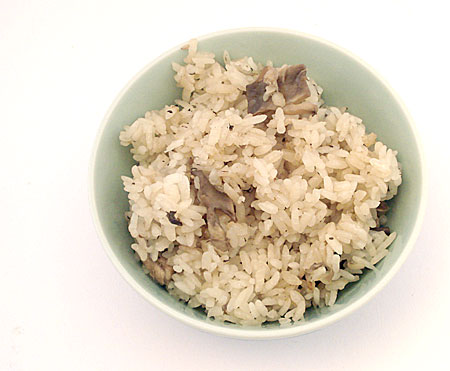
The very first full recipe I posted on Just Hungry almost 4 years ago was Mushroom Rice (kinoko no takikomi gohan), and it still gets a lot of visits and comments, even though there's no photo to whet the reader's appetite or anything.
The original recipe called for traditional dashi stock made from bonito (fish) flakes, and suggested adding chicken and other things.
This version is a lot simpler to assemble and it's all vegan, but it's just as tasty. And it comes with a photo! (My early photos on the site are pretty awful. I like to think I've learned a little since then.) I am using this in an upcoming bento, but it's good for regular dinner too, so it's posted here. It's actually the best when it's freshly made - the aroma of the mushrooms fills the kitchen, quite irresistible if you love mushrooms as I do. It is a very autumn (fall) kind of dish.
I think that this dish reflects my changing tastes and eating habits too, not to mention how I approach writing for Just Hungry, too. 4 years ago, I wasn't that worried about health issues or anything of that nature in regards to food. Now, I am rather proud that I have a tasty dish that is sugar-free, gluten-free (if you use a gluten-free soy sauce), and vegan! I feel a bit trendy.
Filed under:
japanese rice mushrooms fall vegan gluten-free sugar-free
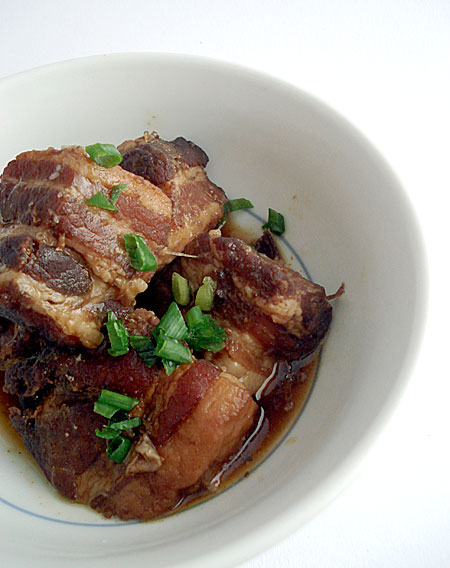
Today is my mother's birthday. In her honor, here is one of the few meat dishes that she still allows in her diet: braised pork belly, or buta no kakuni. It's amazing that she will still eat this, because basically pork belly is bacon without the smoke or salt cure. And in buta no kakuni the bacon, I mean belly, comes in big chunks of layers of meat and unctuous pork fat.
Pork belly recipes exist in other cuisines, especially around northern Europe, but I can't really stand most of them, even if people in Germany and Britain rave about roasted pork belly with crackling. (The crackling part is ok, but the meat part...I don't know.) I like fat in moderation as much as anyone, but that amount of gelatinous pork fat is rather hard to bear. That is unless it's been slowly braised in a salty-sweet liquid for hours and hours, until both the fat and the meat melt in your mouth.
Very similar recipes exist in Chinese (from Peking-style especially) cuisine, and a great Okinawa speciality is _rafute_. This is a bit like rafute but has a bit more spice and things in it, so it's closer to the Peking style I think. Either way it's a great treat once in a great while. It's definitely a cold weather dish.
Filed under:
japanese winter slowcook pork meat
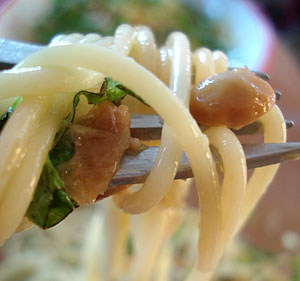
The word wafuu may sound like someone trying to say yahoo and not quite succeeding, but it actually means "Japanese-style" in Japanese.
Italian style pasta has been popular in Japan since the post war period. In the beginning it was served with Italian, or at least Western European, style sauces, but some time in the '70s or so people started to experiment with Japanese flavors. Essentially, things that are usually eaten with white rice were mixed into or put on top of spaghetti and other pastas. These are known as wafuu pasuta or wafuu supagetti (say these out loud and you'll know what they are), and became popular on the menus of Japanese cafés (kissaten) and the like.
There is at least one restaurant in the U.S. that I know of that has a couple of wafuu pasuta dishes on their menu - Basta Pasta (warning: icky Flash-only site!), in New York. They don't really go far enough in my opinion though. If you love Japanese flavors you'll probably love wafuu pasuta too.
Most wafuu pasuta recipes are very quick and easy to make, so they are great for quick dinners. Incidentally, to achieve a more Japanese texture cook the pasta about a minute or so longer than you might otherwise, so it's a bit past al dente. Japanese people generally prefer softer pasta.
Following are three of my favorite quick and easy wafuu pasuta dishes.
Filed under:
japanese natto quickcook yohshoku pasta
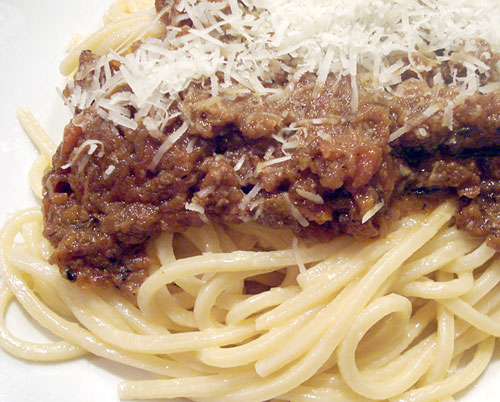
I love pasta in many guises, but when it comes to ultimate Comfort Pasta, there is nothing that compares to a spaghetti bolognese. By spaghetti bolognese, I mean spaghetti topped with a rich, ground-meat and tomato based sauce. No fancy ragu or such. I don't think it's that authentically Italian, but I don't really care. It's one of my favorite cool-weather dinners.
Once upon a time, I had what I thought was a perfect recipe for spaghetti bolognese. Then, about a year ago I lost my way. After a year of bewilderingly off-target bolognese, I've found my way back.
I blame Heston Blumenthal for messing with my head. (Disclaimer: I am otherwise a big fan of Mr. Blumenthal.) Last year, he tackled spaghetti bolognese on his In Search of Perfection television series (and in the book of course), and came up with a "perfect" version. The perfect Blumenthal version of spaghetti bolognese is, naturally, extremely complicated, but compared to the other "perfect" versions of various popular dishes it seemed to be the most doable. So, we (note the plural: it required a team effort) tackled it, piece by piece. It does help in life to have an almost equally food-obsessive partner for such quests.
It took us 3 full days to accomplish, starting from the pre-ordering of the meaty oxtails at the butcher counter (it's not a commonly used cut here), finding the perfect spaghetti, ripe tomatoes in December (yes, I know) and the final slow cooking of the sauce. And the result?
It was good, yes, but perfect? Neither of us was sure. But yet it had flashes of something great in there; the meatiness of the gelatinous oxtail, the unctuous richness. So, we embarked on a long journey of trying to tweak that recipe. We tried different meat combinations. (Turkey is a definite no.) We experimented with bacon, chorizo, various sausages, salami. We tried less or more of the vegetables, canned tomatoes alone or fresh alone.
All were interesting, but I still felt off kilter. Then, the other day I made bolognese more or the way I had made it for years until the Blumenthal experiments - and, it was just about perfect.
Mind you, it's probably because my criteria for a perfect bolognese are different from the great chef's, as I explain below. And some of the ideas gleaned from the Blumenthal version and the ensuing experiments did creep in, making the sauce even better. In any case, I'm now happy that this is my Perfect Spaghetti Bolognese. I can now move on to perfecting other things.
Filed under:
dinner winter sauce pasta favorites italian meat
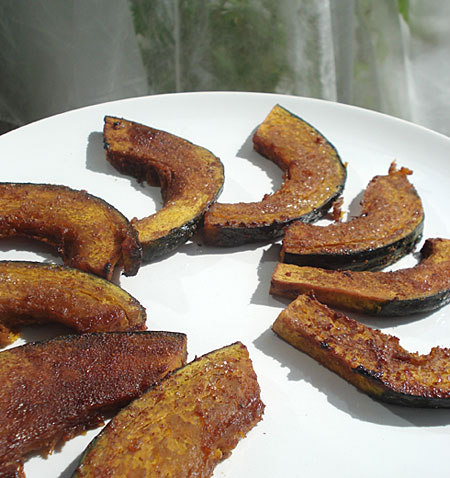
I hesitated to put this recipe up, because it's not the prettiest thing in the world. But it's so tasty, dead easy to make, and of this season - so, here it is. As a bonus it's full of fibre and is relatively low-calorie, low-sugar etc for people who want a bit of something sweet without going on a massive guilt trip.
Most recipes out there for using winter squash seem to involve pureeing them, but I rather like them when they are in chunks or slices. This roasted squash has a sweet, spicy and salty glaze of sorts on them, which brings out the dense sweetness of the fruit. Cut into fairly thin slices like this, it makes interesting finger food. You can vary the sugar and spice to your taste, though too much of either may overwhelm it.
You do need to use kabocha-type squash for this ideally, though butternut should work too. You will need a dense, starchy and sweet squash. Don't use regular pumpkin, which is too watery and lacks sweetness. (Rouge d'etampes pumpkin may work, but I've found their sweetness to vary quite a bit.)
Filed under:
japanese fall vegetarian sweet vegan
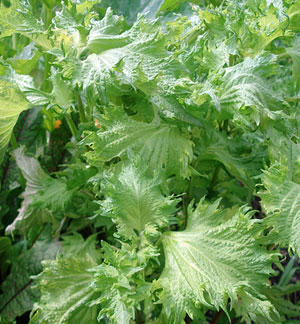
Around here it's already cool enough to declare that summer is over and fall is here. (Actually we had a very cold, wet summer anyway, but nevertheless.) So the summer vegetable plants in my garden are dying off, and I'm in the process of salvaging the remaining tomatoes and eggplants, picking the last zucchini, and eyeing the winter squash to see when they will be ready.
Tender herbs like basil are on their last legs, so I'm picking and preserving those flavors of summer so that they can brighten the dark winter months. Last year I took the lazy option and froze everything, packing the picked leaves in plastic bags and throwing them in our big locker-type freezer. Freezing is okay if you're too busy to do anything else with your herbs, but not really the optimal way all the time to keep tender herbs in the long run. So this year I'm thinking things through a bit more and considering how I want to use each herb, and preserving them accordingly. Each method is quite easy and really doesn't take that much time.
Filed under:
japanese preserves and pickles vegetarian herbs
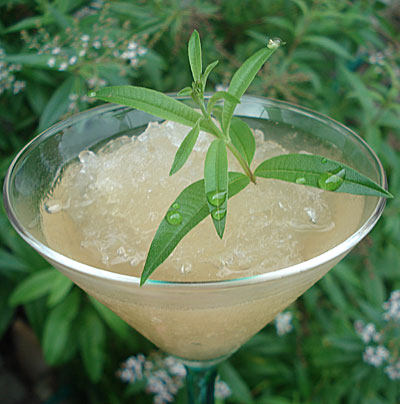
The lemon verbena plant that I planted last year and almost lost to a summer storm, is now firmly established and positively thriving. Whenever I pass it I can't resist rubbing a leaf, because it smells so wonderful.
Transferring that wonderful lemony scent to taste is quite easy - simply steeping it in some boiling water for about 10 to 15 minutes does the trick. This granita is infused with the aroma of lemon verbena, soured with a little lemon juice, and sweetened with a delicate acacia honey. Any light colored honey will work here instead. It makes a wonderful light dessert or palate cleanser, or cooling summer snack.
Filed under:
dessert lighter vegetarian sweet summer tea
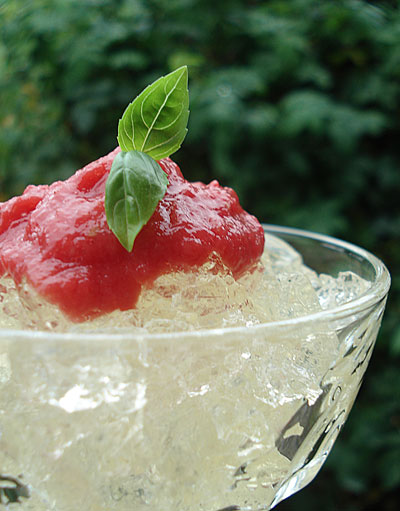
Have you ever made tomato water? It's the clear liquid strained gently from a ripe tomato, and one of the best treats of summer. When made from juicy, vine-ripened tomatoes, it has a sweet yet green-tomatoey taste that is so intense that a little goes a very long way.
Making tomato water is very simple. All it requires is a blender or food processor, a fine mesh sieve, paper towels, and patience. What you do with the resulting water is up to your imagination. Here I have added a little gelatin to make it into a tomato gelée (or, to be non-fancy, jelly). Served on top is a tomato coulis made from the pulp that is left over after the water is strained. The only heat-adding cooking involved is in melting the gelatin. It fits in well with my minimal-cooking mood this summer.
This would make a very interesting first course for a summer meal, or an amuse-bouche if served in tiny portions. It would be a great in-between courses palate cleanser too, if you are having an elaborate meal.
Filed under:
lighter vegetables summer salad low-carb
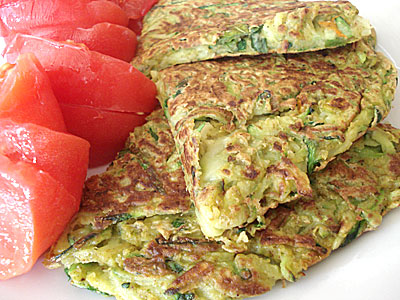
Continuing with my light and quick summer dishes:
This year we got a bit more serious than usual about our garden, and planted three zucchini plants. If you have a garden with zucchinis, you know that sometime around midsummer they start to produce babies like crazy. We've had a rather cold and rainy summer here up until now, but this week our three innocent looking zucchini plants have gone into high gear, and we're picking them as fast as we can before they turn into seedy, tasteless baseball bat sized monsters.
Zucchini pancakes are one way to use up a lot at once. This version uses chickpea flour instead of wheat flour or eggs, with a little bit of spice in it. It's great hot or cold, and is a perfect snack, side dish or complete vegan main dish, since the chickpea flour is such a terrific source of protein and carbs (nutritional info). Serve it with a salsa, curry, or just on its own. Here I just served them with some super-ripe tomato wedges. The shredded zucchini adds moisture and a rather creamy texture, which I love.
Chickpea flour is used in Mediterranean and Indian cooking. I get mine from a local Indian grocery store, where it's sold as gram flour; it's also known as besan, ceci flour, and so on.
Filed under:
lighter vegetables vegetarian summer vegan gluten-free
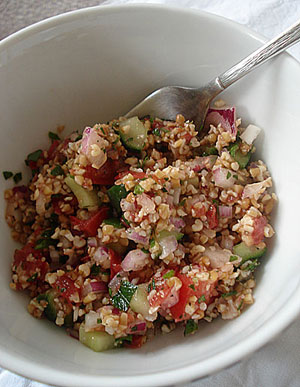
I haven't been posting a lot of recipes here recently. This is mainly because I haven't actually been doing a lot of full-on cooking, as in hauling out a lot of pots and pans and having the oven full blast and so on. It's summer after all, and I've been enjoying fruits and vegetables as close to their natural, fresh, ripe state as possible. So this week I'll be posting a few such recipes - requiring minimal active cooking, full of fresh summer vegetables, and nice to have on a warm summer day or evening.
The first one is my standard recipe for tabbouleh, with a twist - instead of using mint, I use shiso (perilla). Shiso has a slightly minty but wholly unique flavor which I really like in just about anything. I also make it with a lot less olive oil than most recipes call for, which I think adds to the fresh taste. We love to have a bowl of tabbouleh in the fridge for easy self-service lunch and snacks throughout the day - it tastes so healthy and is quite filling. It's also a great side dish for a barbeque.
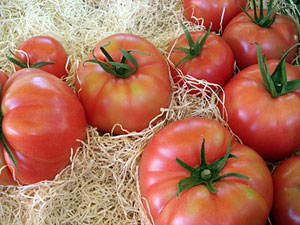
Fresh tomatoes are the key to a great tabbouleh in my opinion. You need ones that are ripe and full of flavor, yet firm. One of my favorite tomatoes at the moment are an heirloom Swiss variety called Berner Rosen - they are a rosy pink when ripe, and full of juice and flavor. (If you're in Switzerland, Berner Rosen are all over the place at the markets right now.) If you can't get hold of a good heirloom variety like this, use cherry tomatoes, which are usually reliably firm yet flavorful.
Filed under:
lighter summer vegan salad
Pages